|
Paddy field is generally subjected to many cycles of alternate flooding and drying (AFD) during rice growing. AFD may create many remarkable cracks in the field. But the characteristics of soil cracks in 2D and 3D and their consequences on preferential flow are not well understood. Professor Xinhua Peng’s group has done a lot of work to figure out theissuesand the finding has been published in Geoderma (http://dx.doi.org/10.1016/j.geoderma.2013.07.026)
In this study, two paddy fields, one cultivated for 20 years (YPF) and the other cultivated for more than 100 years (OPF), weresubjected to either alternate flooding and drying (AFD) or continuous flooding (CF) as a controlduring rice growing season. After the harvest of late rice crop, soil cracks were analyzed in 2D and 3D, and their contributions to hydraulic conductivity and preferential flow were assessed by tension infiltrometer and dye tracer, respectively. The results showed that cracks were generated under AFD condition but not under CF condition. Under AFD condition, the YPF presented 10-fold more cracks but they were finer and shallower as compared with those in the OPF. All the cracks did not penetrate through the plow pan. Soil cracks in the two paddy fields increased soil hydraulic conductivity and represented the pathways of preferential flow. However, the preferential flow was considerably reduced by the dense plow pan. This study indicates that paddy soil cracks generated by AFD cycles can improve water infiltration but its role in preferential flow is minor below the plow pan.
In previous studies, most of researchers found preferential flow through cracks was obvious and serious in paddy field. But our study find if the cracks do not penetrate through plow pan, the preferential flow caused by soil cracks is confined in plough layer of paddy field. Our study improved the understanding of the effect of soil cracks on preferential flow in paddy field.
|

|
|
Figure 1. Example of three-dimensional (3D) largest crack in the YPF and OPF under AFD condition.
The image is in 6.4 × 6.4 × 9 cm size
|

| 